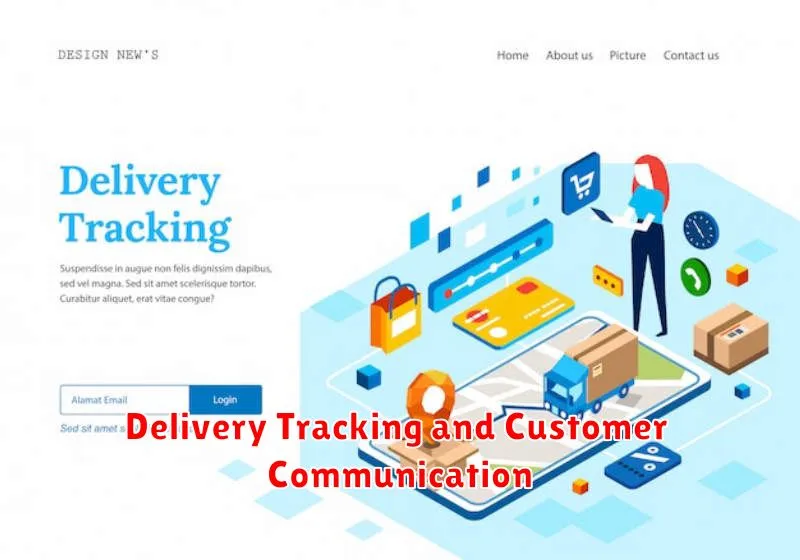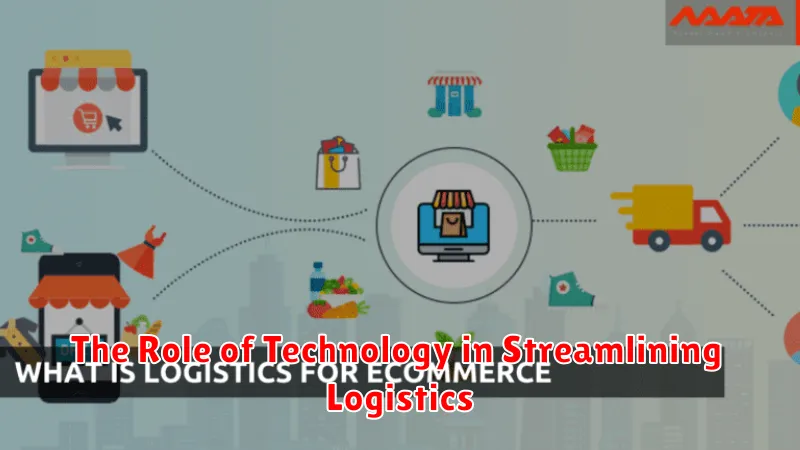Online shopping has revolutionized the way we acquire goods, transforming the retail landscape from brick-and-mortar stores to the digital marketplace. This seemingly simple act of clicking “add to cart” and proceeding to checkout initiates a complex network of logistics, a carefully orchestrated process that ensures your desired products arrive at your doorstep. This article provides a deep dive into the intricacies of these processes, unraveling the journey of your purchase from the virtual shelf to your physical possession. Understanding the logistics of online shopping is crucial for both consumers seeking a smooth shopping experience and businesses aiming to optimize their supply chains.
From warehouse management and order fulfillment to shipping and delivery, the logistics of online shopping encompass a multitude of interconnected operations. This exploration will examine each stage of the process, highlighting the key players involved, the technological advancements driving efficiency, and the challenges faced in maintaining a seamless flow of goods. Prepare to delve into the world behind the screen, gaining valuable insights into the complex processes that make online shopping possible. This deep dive will unravel the critical components of e-commerce logistics, providing a comprehensive understanding of the journey your purchases undertake.
Order Processing and Inventory Management
Effective order processing and inventory management are critical to the success of any online retail operation. A streamlined order processing system ensures that customer orders are received, verified, and processed quickly and accurately.
This involves several key steps: order placement by the customer, payment processing, order verification (checking for fraud or inconsistencies), and order confirmation communicated back to the customer. Each step must be optimized for speed and efficiency.
Inventory management plays a vital role in fulfilling customer orders. Accurate inventory tracking ensures that businesses have enough stock on hand to meet demand, while minimizing excess inventory and associated costs. This involves real-time monitoring of stock levels, accurate forecasting of future demand, and efficient replenishment strategies.
Sophisticated inventory management systems often employ techniques like SKU management, barcode scanning, and cycle counting to maintain precise inventory records and minimize errors. Integrating order processing with inventory management systems allows for automatic updates and streamlined operations, ultimately leading to improved customer satisfaction and profitability.
Warehouse Operations and Order Fulfillment
Efficient warehouse operations are crucial for fulfilling online orders promptly and accurately. Warehouse layout plays a vital role in optimizing workflows. Strategic placement of inventory, packing stations, and shipping areas minimizes travel time and streamlines processes.
Inventory management systems track stock levels in real-time, ensuring accurate order fulfillment and preventing stockouts. These systems automate tasks like receiving inventory, updating stock counts, and generating picking lists. Order fulfillment involves picking, packing, and preparing orders for shipment. Efficient picking methods, like zone picking or wave picking, improve speed and accuracy.
Quality control checks at various stages, such as receiving and packing, minimize errors and ensure customer satisfaction. Automation technologies like automated guided vehicles (AGVs) and robotic systems can further enhance warehouse efficiency and throughput.
Shipping Options and Carrier Selection
A crucial aspect of online order fulfillment lies in selecting appropriate shipping options and carriers. Offering a variety of shipping methods caters to diverse customer needs and preferences. Standard shipping provides an economical choice for non-urgent deliveries, while expedited options like express or overnight shipping cater to time-sensitive orders.
Carrier selection hinges on factors like delivery speed, cost-effectiveness, reliability, and geographic reach. Businesses must carefully evaluate different carriers, comparing their strengths and weaknesses to identify the best fit for their specific requirements. Factors such as package dimensions and weight influence shipping costs, and businesses often negotiate rates with carriers to optimize expenses.
Offering flexible shipping choices enhances customer satisfaction and can be a key differentiator in a competitive market. Clear communication of shipping costs and estimated delivery times is essential for managing customer expectations and building trust.
Packaging and Handling Best Practices
Effective packaging and handling are crucial for ensuring products reach customers in perfect condition. This involves selecting appropriate materials and implementing procedures that minimize damage during transit.
Choosing the right packaging materials is the first step. Consider the product’s fragility and the potential hazards it might encounter during shipping. Durable boxes, protective cushioning (such as bubble wrap or air pillows), and secure sealing tape are essential. For fragile items, custom-fit inserts or molded pulp can provide added protection.
Proper handling techniques within the warehouse are equally important. This includes training employees on safe lifting practices to prevent strain and minimize the risk of dropping packages. Designated packing stations with adequate space and appropriate tools contribute to efficient and organized workflows.
Clearly labeled packages facilitate smooth processing throughout the supply chain. Accurate labeling with the correct shipping address and any necessary handling instructions (e.g., “Fragile,” “This Side Up”) helps prevent misrouting and ensures proper care during transit.
Delivery Tracking and Customer Communication

Transparent and timely communication is crucial throughout the delivery process. Customers expect to be kept informed of their order’s journey from warehouse to doorstep.
Tracking information, typically provided through a unique tracking number, allows customers to monitor their package’s location and estimated delivery date. This real-time visibility reduces anxiety and manages expectations effectively. Proactive updates through email or SMS notifications at key milestones, such as shipment confirmation, out-for-delivery alerts, and delivery confirmation, further enhance the customer experience.
Effective communication channels also play a vital role in resolving delivery issues. Providing accessible customer support via email, phone, or chat empowers customers to quickly address concerns like delayed deliveries or incorrect addresses. Clear and concise communication regarding potential delays, along with alternative solutions, helps maintain trust and satisfaction.
Returns Management and Reverse Logistics
Returns management is a crucial aspect of online shopping logistics. It encompasses the processes involved in handling returned products from customers. A well-defined returns process is essential for customer satisfaction and can significantly impact a business’s bottom line.
Reverse logistics, on the other hand, refers to the movement of goods from their typical destination back to the seller. This involves the steps taken to receive, process, and potentially resell, refurbish, or dispose of returned items.
Effective returns management requires streamlined procedures for authorizing returns, providing return shipping labels, and processing refunds or exchanges. Clear communication with the customer throughout the returns process is key. A seamless return experience builds trust and encourages repeat business.
Reverse logistics operations must be optimized for efficiency to minimize costs. This includes finding cost-effective shipping solutions, effectively managing inventory of returned goods, and minimizing processing time.
Strategies for Optimizing Logistics Costs
Optimizing logistics costs is crucial for maintaining profitability in online retail. Efficient strategies can significantly impact the bottom line.
Negotiating favorable shipping rates with carriers is a primary step. Volume discounts and long-term contracts can help reduce per-package costs. Another key strategy involves optimizing warehouse locations. Strategically placed warehouses can minimize transportation distances and delivery times.
Packaging optimization also plays a significant role. Using appropriately sized packaging reduces both material costs and shipping expenses, as dimensional weight pricing becomes less of a factor. Exploring alternative shipping methods can also yield savings. Utilizing regional carriers or consolidating shipments can be more cost-effective than relying solely on major national carriers.
Finally, inventory management is paramount. Accurate forecasting and efficient inventory control minimize storage costs and prevent overstocking or stockouts, which can lead to lost sales and increased expenses.
The Role of Technology in Streamlining Logistics

Technology plays a critical role in optimizing the complex landscape of online shopping logistics. From warehouse management to last-mile delivery, technological advancements drive efficiency and cost reduction.
Warehouse Management Systems (WMS) automate inventory tracking, storage optimization, and order fulfillment. These systems provide real-time visibility into stock levels, enabling businesses to accurately predict demand and prevent stockouts or overstocking.
Transportation Management Systems (TMS) streamline shipping processes by automating route planning, carrier selection, and freight tracking. TMS platforms leverage data analysis to optimize delivery routes and minimize transportation costs.
Furthermore, advancements in data analytics and machine learning provide valuable insights into consumer behavior, allowing businesses to anticipate demand fluctuations and proactively adjust their logistics strategies.
International Shipping Considerations
Navigating international shipping presents unique complexities for both businesses and consumers. Customs regulations vary significantly between countries, impacting documentation, duties, and taxes. Understanding these regulations is crucial for avoiding delays and unexpected costs.
Shipping costs for international orders are typically higher due to increased distances and logistical hurdles. Factors such as package weight, dimensions, destination country, and shipping method all play a role in determining the final cost. Businesses must clearly communicate these costs to customers upfront to manage expectations.
Delivery times are often longer for international shipments. Transit times can vary based on distance, customs processing times, and the chosen shipping carrier. Providing customers with realistic delivery estimates and tracking information is essential for a positive shipping experience.
Currency exchange rates are another important consideration. Businesses operating internationally must manage transactions in multiple currencies, factoring in potential fluctuations that could impact profit margins. Clearly displaying prices in the customer’s local currency can improve the shopping experience.

